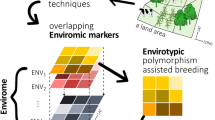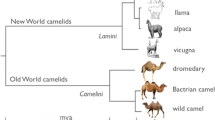Abstract
A Duroc–Pietrain resource population was built to detect quantitative trait loci (QTL) that affect growth, carcass composition, and pork quality. The data were analyzed by applying three least-squares Mendelian models: a line-cross (LC) model, a half-sib (HS) model, and a combined LC and HS model (CB), which enabled the detection of QTL that had fixed, equal, and different allele frequencies for alternate breed alleles, respectively. Permutation tests were performed to determine 5% chromosome-wide and 5% genome-wide threshold values. A total of 40 (137) QTL were detected at the 5% genome-wide (chromosome-wide) level for the 35 traits analyzed. Of the 137 QTL detected, 62 were classified as the LC type (LC-QTL), 47 as the HS type (HS-QTL), and 28 as the CB type (CB-QTL). The results indicate that implementation of a series of model-based framework is not only beneficial to detect QTL, but also provides us with a new and more robust interpretation from which further methodology could be developed.


Similar content being viewed by others
References
Alfonso L, Haley CS (1998) Power of different F2 schemes for QTL detection in livestock. Anim Sci 66:1–8
Bidanel JP, Milan D, Iannuccelli N, Amigues Y, Boscher MY et al (2001) Detection of quantitative trait loci for growth and fatness in pigs. Genet Sel Evol 33:289–309
Churchill GA, Doerge RW (1994) Empirical threshold values for quantitative trait mapping. Genetics 138:963–971
Dekkers J, Kim JJ, Malek M, Thomsen H, Lee H et al (2003) A genome scan to detect QTL affecting growth, composition, and meat quality trait in a Berkshirer × Yorkshire cross. 28th National Swine Improvement Federation Proc, December 4–5, 2003, Des Moines, IA
De Koning DJ, Janss LL, Rattink AP, van Oers PA, de Vries BJ et al (1999) Detection of quantitative trait loci for backfat thickness and intramuscular fat content (Sus scrofa). Genetics 152:1679–1690
De Koning DJ, Rattink AP, Harlizius B, van Arendonk JAM, Brascamp EW et al (2000) Genome-wide scan for body composition in pigs reveals important role of imprinting. Proc Natl Acad Sci USA 97:7947–7950
De Koning DJ, Harlizius B, Rattink AP, Groenen MA, Brascamp EW (2001) Detection and characterization of quantitative trait loci for meat quality traits in pigs. J Anim Sci 79:2812–2819
De Koning DJ, Pong-Wong R, Varona L, Evans GJ, Giuffra E et al (2003) Full pedigree quantitative trait locus analysis in commercial pigs using variance components. J Anim Sci 81:2155–2163
Estelle J, Mercade A, Noguera JL, Perez-Enciso M, Ovilo C et al (2005) Effect of the porcine IGF2-intron3–G3072A substitution in an outbred Large White population and in an Iberian × Landrace cross. J Anim Sci 83:2723–2728
Evans GJ, Giuffra E, Sanchez A, Kerje S, Davalos G et al (2003) Identification of quantitative trait loci for production traits in commercial pig populations. Genetics 164:621–627
Green P, Falls K, Crooks S (1990) Documentation for CRIMAP version 2.4. Washington University School of Medicine, St. Louis, MO
Haley CS, Knott SA, Elsen JM (1994) Mapping quantitative trait loci in crosses between outbred lines using least squares. Genetics 136:1195–1207
Jungerius BJ, Van Laere AS, Te Pas MF, Van Oost BA, Andersson L et al (2004) The IGF2-intron3–G3072A substitution explains a major imprinted QTL effect on backfat thickness in a Meishan European white pig intercross. Genet Res 84:95–101
Kim JJ, Rothschild MF, Beever J, Rodriguez-Zas S, Dekkers JCM (2005a) Joint analysis of two breed cross populations in pigs to improve detection and characterization of quantitative trait loci. J Anim Sci 83:1229–1240
Kim JJ, Zhao H, Thomsen H, Rothschild MF, Dekkers JCM (2005b) Combined line-cross and half-sib QTL analysis of crosses between outbred lines. Genet Res 85:235–248
Knott SA, Elson JM, Haley CS (1996) Methods for multimarker mapping of quantitative trait loci in half-sib populations. Theor Appl Genet 93:71–80
Krzecio E, Kuryl J, Kocwin-Podsiadla M, Monin G (2005) Association of calpastatin (CAST/MspI) polymorphism with meat quality parameters of fatteners and its interaction with RYR1 genotypes. J Anim Breed Genet 122:251–258
Liu G, Jennen DGJ, Tholen E, Juengst H, Kleinwächter T et al (2007) A genome scan reveals QTL for growth, fatness, leanness and meat quality in a Duroc–Pietrain resource population. Anim Genet 38:241–252
Meyers SN, Rodriguez-Zas SL, Beever JE (2007) Fine-mapping of a QTL influencing pork tenderness on porcine chromosome 2. BMC Genet 8:69
Milan D, Bidanel JP, Iannuccelli N, Riquet J, Amigues Y et al (2002) Detection of quantitative trait loci for carcass composition traits in pigs. Genet Sel Evol 34:705–728
Nagamine Y, Haley CS, Sewalem A, Visscher PM (2003) Quantitative trait loci variation for growth and obesity between and within lines of pigs (Sus scrofa). Genetics 164:629–635
Nagamine Y, Visscher PM, Haley CS (2004) QTL detection and allelic effects for growth and fat traits in outbred pig populations. Genet Sel Evol 36:83–96
Quackenbush J (2007) Extracting biology from high-dimensional biological data. J Exp Biol 210:1507–1517
Quintanilla R, Demeure O, Bidanel JP, Milan D, Iannuccelli N et al (2003) Detection of quantitative trait loci for fat androstenone levels in pigs. J Anim Sci 81:385–394
Rattink AP, De Koning DJ, Faivre M, Harlizius B, van Arendonk JA et al (2000) Fine mapping and imprinting analysis for fatness trait QTLs in pigs. Mamm Genome 11:656–661
Rohrer GA, Keele J (1998) Identification of quantitative trait loci affecting carcass composition in swine. II. Muscling and wholesale product yield traits. J Anim Sci 76:2255–2262
Rohrer GA, Thallman RM, Shackelford S, Wheeler T, Koohmaraie M (2006) A genome scan for loci affecting pork quality in a Duroc-Landrace F2 population. Anim Genet 37:17–27
Su YC, Deng CY, Xiong YZ, Zheng R, Yu L et al (2002) The construction of the genetic map and QTL locating analysis on chromosome 2 in swine. Acta Genet Sin 29(11):972–976
Tribout T, Iannuccelli N, Druet T, Gilbert H, Riquet J et al (2008) Detection of quantitative trait loci for reproduction and production traits in LargeWhite and French Landrace pig populations. Genet Sel Evol 40:61–78
van Wijk HJ, Buschbell H, Dibbits B, Liefers SC, Harlizius B et al (2007) Variance component analysis of quantitative trait loci for pork carcass composition and meat quality on SSC4 and SSC11. J Anim Sci 85:22–30
Yue G, Stratil A, Cepica S, Schroeffel J Jr, Schroeffelova D et al (2003) Linkage and QTL mapping for Sus scrofa chromosome 7. J Anim Breed Genet 120(1):56–65
Acknowledgment
This project was supported by the German Research Foundation, DFG grant FOR753 DRIP, Germany; and partly by the Korea Rural Development Administration in Korea, Bio_Green 21 project (No. 20080401-034-053-008-04-00). The authors are indebted to the Frankenforst research station for animal breeding and performance testing work.
Author information
Authors and Affiliations
Corresponding author
Additional information
G. Liu and J. J. Kim contributed equally to this work.
Rights and permissions
About this article
Cite this article
Liu, G., Kim, J.J., Jonas, E. et al. Combined line-cross and half-sib QTL analysis in Duroc–Pietrain population. Mamm Genome 19, 429–438 (2008). https://doi.org/10.1007/s00335-008-9132-y
Received:
Accepted:
Published:
Issue Date:
DOI: https://doi.org/10.1007/s00335-008-9132-y




